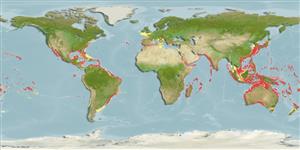Ascidiacea |
Phlebobranchia |
Corellidae
Environment: milieu / climate zone / depth range / distribution range
Ecology
Sessile; depth range 37 - 174 m (Ref. 1134). Tropical
Indo-Pacific, Atlantic Ocean and the Mediterranean. Tropical and subtropical.
Length at first maturity / Size / Weight / Age
Maturity: Lm ? range ? - ? cm Max length : 4.0 cm TL male/unsexed; (Ref. 86424)
Identified as a possible Lessepsian migrant, present at least in Red Sea and eastern Mediterranean (Ref. 85347). Minimum depth from Ref. 116065. Found in shallow waters (Ref. 415 and 1134); mangrove areas particularly Rhizophora sp. roots, piers and pilings (Ref. 86424).
Life cycle and mating behavior
Maturity | Reproduction | Spawning | Eggs | Fecundity | Larvae
Members of the class Ascidiacea are hermaphroditic; both cross- and self-fertilization is typical. Life cycle: Eggs develop into lecithotrophic larva before metamorphosing into benthic adults.
Collin, R., M.C. Díaz, J. Norenburg, R.M. Rocha, J.A. Sánchez, M. Schulze, A. Schwartz and A. Valdés 2005 Photographic identification guide to some common marine invertebrates of Bocas Del Toro, Panama. Caribbean Journal of Science. 41(3):638-707. (Ref. 415)
IUCN Red List Status
(Ref. 130435: Version 2025-1)
CITES status (Ref. 108899)
Not Evaluated
Not Evaluated
Threat to humans
Human uses
| FishSource |
Tools
More information
Trophic EcologyFood items (preys)
Diet composition
Food consumption
Predators
Population dynamicsGrowthMax. ages / sizesLength-weight rel.Length-length rel.Length-frequenciesMass conversionAbundance Life cycleReproductionMaturityFecunditySpawningEggsEgg developmentLarvae PhysiologyOxygen consumption
Human RelatedStamps, coins, misc.
Internet sources
Estimates based on models
Preferred temperature
(Ref.
115969): 12.8 - 21.2, mean 18 (based on 44 cells).
Fishing Vulnerability
Low vulnerability (10 of 100).
Price category
Unknown.
